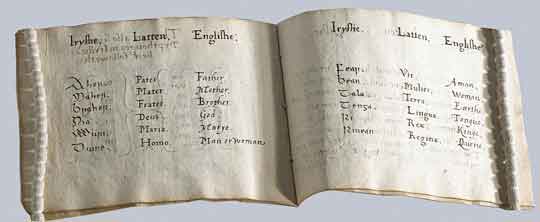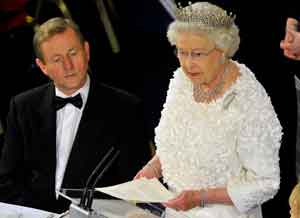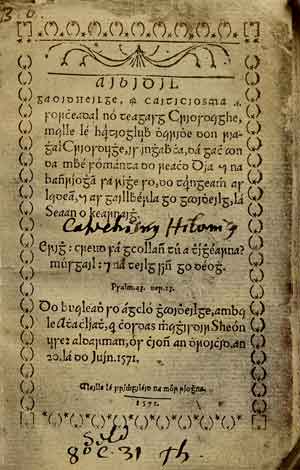FROM ELIZABETH TO ELIZABETH
Published in Features, Issue 2 (March/April 2023), Volume 31By Dermot McGuinne
When Queen Elizabeth II used five simple words in Irish, ‘A Uachtaráin agus a chairde’, in beginning her address at the banquet held in her honour at Dublin Castle on the occasion of her state visit to Ireland in 2011, the reaction was immediate and profound. Even President McAleese seemed surprised, although earlier she is said to have suggested the idea herself and at the time wrote down the words for the queen, together with a phonetic version to help with the pronunciation. The idea was initially rejected by those royal advisers charged with helping to compile the queen’s speech on the grounds that any mispronunciation might lead to embarrassment, but this seemingly last-minute impromptu insertion attracted much praise even amongst royal sceptics. Taken together with the overall tone of her address, it was heralded as having contributed significantly to the improvement of relations between the UK and Ireland at the time.

Above: Pages from the primer of the Irish language prepared for Queen Elizabeth I by Christopher Nugent, Baron of Delvin, c. 1560–5. (Marsh’s Library)
It was the first attempt in over 500 years by a British monarch to reference the Irish language in a positive manner. Over the centuries, as the debate raged regarding the use of the Irish language—with religious proselytising and a State determination to Anglicise the native population on the one hand and a desire to retain the cultural distinctiveness that the language afforded among those of a more nationalistic persuasion on the other—successive monarchs remained largely indifferent to the matter. (It is perhaps worth noting that in the early nineteenth century the Irish scholar and author Thaddeus Connellan, who had involved himself in the production of the so-called Fry irish printing typeface, attributed, rather dubiously, the financial sponsorship for the project to King George IV. There is, however, no evidence to support this suggestion. Connellan, it seems, was wont to associate himself with royal patronage.)
Queen Elizabeth I

Above: Queen Elizabeth speaking at the banquet held in her honour at Dublin Castle in 2011. (Irish Times/David Sleator)
It is in Queen Elizabeth II’s namesake Queen Elizabeth I in the sixteenth century that evidence of a positive interest can again be found, although with a different purpose in mind from that of the later queen. Elizabeth I sought to spread the doctrines of the reformed Protestant church amongst the native Irish-speaking population. Moreover, it is said that she liked being able to address visitors to her court in their native language. To facilitate her in this regard, around 1560–5 she had Christopher Nugent, Baron of Delvin, prepare a manuscript, referred to as an ‘Iryshe–Latten–English Primer’. The primer is undated, but it is likely that it was presented to the queen in 1564 on the occasion of her visit to the University of Cambridge, where Nugent had been studying at the time. It depicts the letters of the Irish alphabet together with a number of simple phrases in Irish with Latin and English translations. In the introduction Nugent pays tribute to the queen for her interest in the Irish language:
‘Among the manifold actions … that beare testymonie to the worlde of your maiestyes great affection, tending to the reformation of Ireland, there is noe one (in my opinion) that more euydent showithe the same, then the desyer your Highnes hath to vnderstande the language of your people theare.’
Furthermore, Elizabeth ordered that religious ministers be instructed in the use of the language so that they could communicate with their congregations. In addition, she instructed that the religious texts of the reformed church be printed in the vernacular—a trend that was well under way in the rest of her realm. She provided the considerable sum of £66 13s. 4d. for this purpose, and charged the bishops of Armagh and Meath to undertake the task, which included the provision of a suitable type font for the printings. Shortly after, in the absence of any progress in the matter, a demand for the repayment of the money was made and the project stalled for a number of years.
A NEW IRISH TYPE
In 1570 attention turned again to the production of an irish type, this time through the efforts of John Kearney and Nicholas Walsh, both students also at Cambridge University, who were later to become treasurer and chancellor respectively of St Patrick’s Cathedral in Dublin. The type was made available within a year at the cost of £22 13s. 4d. With their academic backgrounds, it is unlikely that either of them had the skills needed to become directly involved in the production process, although—indirectly at least—Kearney seems to have played a significant supervisory role in the matter. The first book in which the type was used was a 56-page primer and catechism, Aibidil Gaoidheilge agus Caiticiosma, in 1571, and on its title-page it is stated that it was printed ‘at the expense of John Usher, alderman, [at his house] over the bridge’, referring to the bridge over the River Liffey at the bottom of present-day Bridgefoot Street. The book was prepared by the above-mentioned John Kearney, and in his preface he made mention of the typeface (in translation):
‘Here you have, O reader, the first fruits and progeny of that good and very laborious work which I have been producing and devising for you for a long time, that is, the true and perfect type of the Gaelic language which will open to you that road which leads you to knowledge and which, moreover, has been closed to you formerly … I have undertaken (as I saw no one else who would do so) the labour and toil of bringing this type to the form in which it is now seen.’
He acknowledged the role of the queen in providing the funding for its preparation, explained his rationale in undertaking the project and invited any constructive criticism that might lead to improvements in later versions:

Above: Title-page of Aibidil Gaoidheilge agus Caiticiosma (1571), the first book in which the Queen Elizabeth irish type was used.
‘… since every beginning is in itself feeble, and since it is very easy to add to things newly acquired when they are deficient, I pray that each one of you individually who will be a just judge of this work (which I began in order to proclaim the glory of God and to illuminate and adorn well this public good with this treasure) not to revile or insult or disparage it nor myself because of it as a recompense, but wherever you find a fault or blemish in it to do your utmost to correct and improve it so that it may be more perfect than it is.’
Possibly prior to the printing of this catechism, also in 1571, the type was used to print Tuar ferge foighide Dhé, a poem on the Last Judgement by the Franciscan Philip Bocht Ó hUiginn. The only copy extant of this broadside shows a fainter impression on the reverse side, suggesting that this copy may have been a sample make-ready specimen of the press. It was presented by Matthew Parker, archbishop of Canterbury, to Corpus Christi College, Cambridge, where, as indicated above, the Irishmen Christopher Nugent, John Kearney and Nicholas Walsh had been enrolled as students. Parker had a keen interest in Irish and Anglo Saxon manuscripts and had the Elizabethan printer John Daye cut some brass type punches in the anglo-saxon style. A handwritten inscription at the top of the above-mentioned broadside states ‘This Irishe balade printed in Irlande who belike use the olde Saxon carecte’, leading some commentators to believe incorrectly that the irish type was one and the same as Parker’s anglo-saxon. This hybrid irish font was made up from the existing roman letters of Pierre Haultin and newly cut irish characters. In addition, it incorporated a range of special ligature sorts commonly found in Irish manuscripts. Despite the mixture of styles, the font forms a highly legible text and, partly as a result of the discipline of Haultin’s roman letters, it achieves an orderly appearance on the page.
THE PRINTER?
Apart from the fact that the catechism and broadside were printed at the house of John Usher there is no firm evidence to identify the printer involved. He was most likely William Kearney, a relation of the above-mentioned John who had been sent over to Ireland to print the long-awaited New Testament in Irish, although it was not until 1602–3, the year of Queen Elizabeth’s death, that it was finally printed by John Franke, successor to William Kearney. The dedication mentions that the queen, ‘even in the beginning of her most happie raigne (out of her motherly care, and princely bountie) provided the Irish characters and other instruments for the presse, in the hope that God in mercy would arise up some to translate the Newe Testament into their mother tongue’. The type was next used in 1608 to print The Book of Common Prayer in Irish, also produced by Franke. He was succeeded as the official printer in Ireland by three members of the Company of Stationers of London, which produced just one book using the irish type, The A,B,C. or The Institution of a Christian … in 1631. Later, in 1639, William Bladen took over the role of king’s printer, and he too produced just one book of any significance that used the typeface, namely The Christian Doctrine, or the Foundation of the Christian Religion, Gathered into Six Principles … (1652). It seems that the type was brought to London, where in the hands of the printer John Crooke it was used on a number of occasions merely to print a word or two in Irish. Subsequently it seems to have disappeared from use, possibly melted down to cast other types, for had it been available in a more complete form it could have been put to good use. Whatever its fate, it was noted later in 1680 that when the scientist and philosopher Robert Boyle sought to print William Bedell’s translation of The Old Testament in Irish the Elizabethan type was unavailable, leading him by necessity to go to the expense of having a new typeface produced.
Over the centuries that followed, the use of the Irish language—and in particular its manifestation in print—took on a huge religious, social and political significance. Over twenty different printing types were produced, often coinciding with various nationalistic revolutionary activities. It is hardly likely that Queen Elizabeth, despite the contrite tone of her generous expressions of reconciliation and regret, could have been aware of the depth of feeling she touched upon, aided in no small manner by her brief few words in Irish.
Dermot McGuinne is the retired Head of the Departments of Fine Art and Visual Communication Design at the Technological University of Dublin.
Further reading
B. Dickins, ‘The Irish Broadside of 1571’, Transactions of the Cambridge Bibliographical Society 1 (1949), 48–60.
E.R.McC. Dix, Printing in Dublin prior to 1601 (2nd edn, Dublin, 1932).
D. McGuinne, Irish type design—a history of printing types in the Irish character (2nd edn, Dublin, 2010).
Brian Ó Cuiv (ed.), Aibidil Gaoidheilge agus Caiticiosma (Dublin, 1994).
















